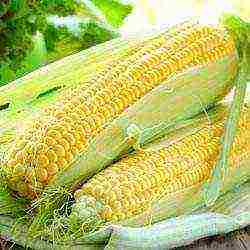Content [show]
Cutting is the easiest way to propagate hydrangeas of any kind. Lignified cuttings root poorly, so it is better to use annual green shoots. In this article, we will tell you in detail how to grow a spectacular hydrangea from a cutting.
Hydrangea can be propagated by cuttings in both spring and summer. But the most suitable time for this business is the middle of summer (shortly before the beginning of flowering). Therefore, it is recommended to cut cuttings from the bush at the moment when the buds have just begun to be tied on the plant. But at the same time it is important not to hold out until the lignification of the shoots, otherwise the cuttings will take root with difficulty.
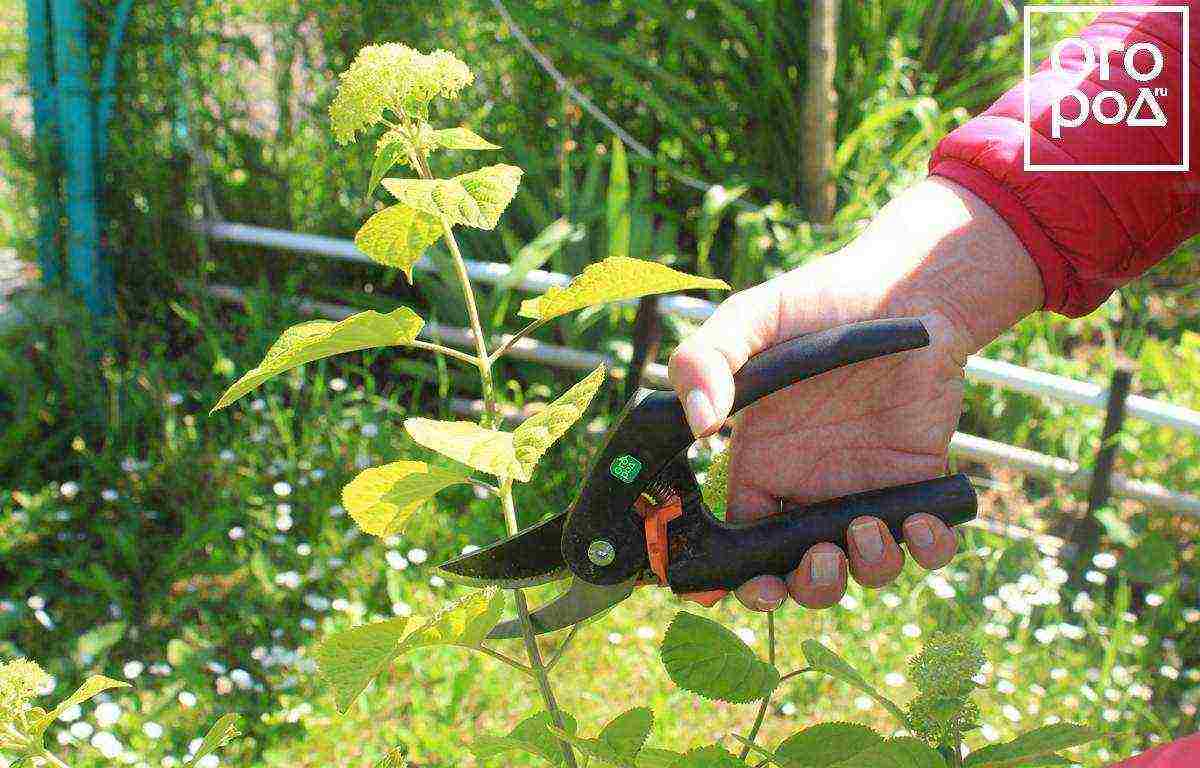
Shoots are best cut early in the morning. To prevent them from wilting, keep hydrangea cuttings in water until grafting.
What should be cuttings of hydrangea?
For cuttings of hydrangeas in spring and summer, it is necessary to cut off the top of a young lateral shoot with 2-3 pairs of leaves. In this case, the two lower leaves should be removed and an oblique cut (at an angle of 45 degrees) should be made on the handle just below the node. The upper cut is made straight and all remaining leaves are shortened by half.
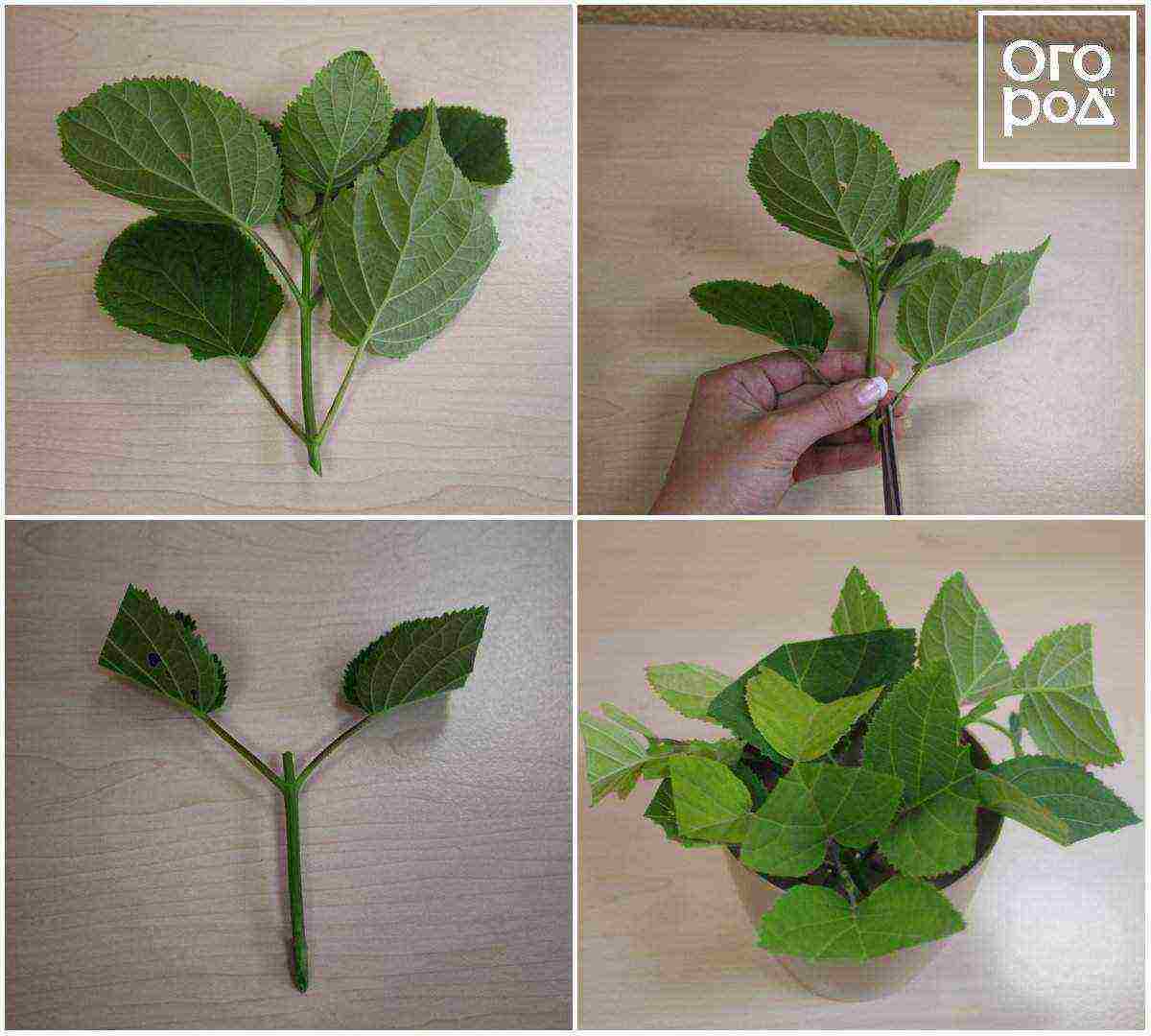
If buds have already formed on the shoots of the hydrangea, then the top with the inflorescence must be cut off.
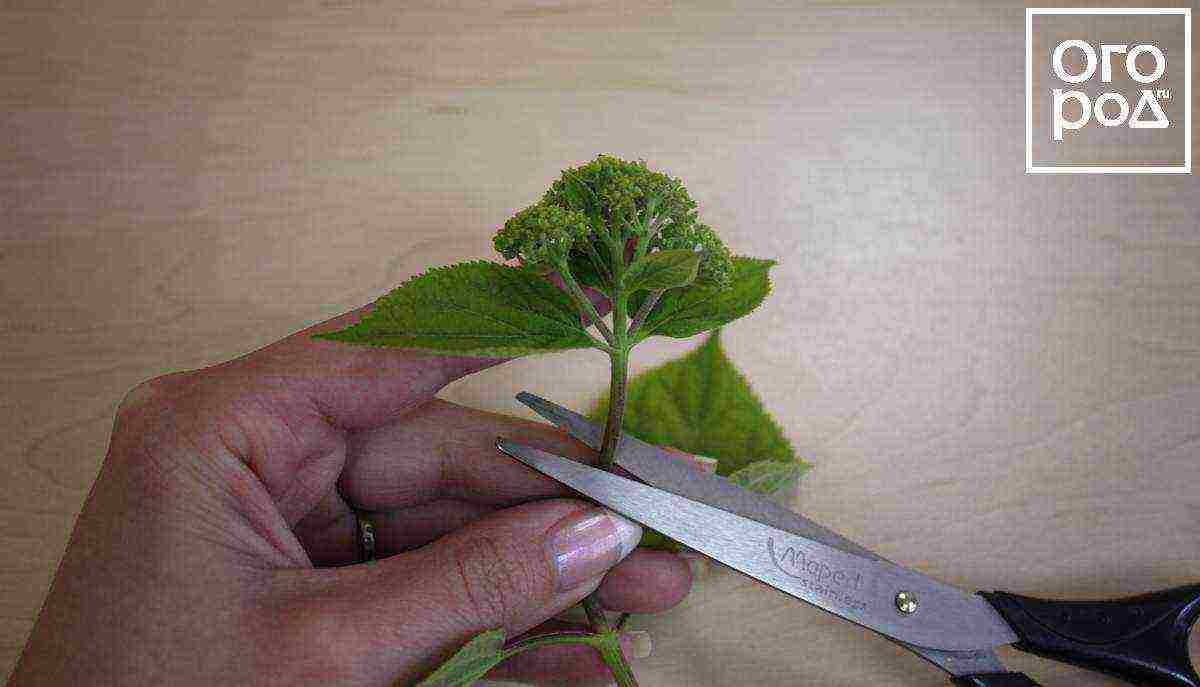
In order for rooting to be successful, it is recommended to soak the cuttings in a solution of a growth stimulator (Epin or HB101) - according to the instructions.
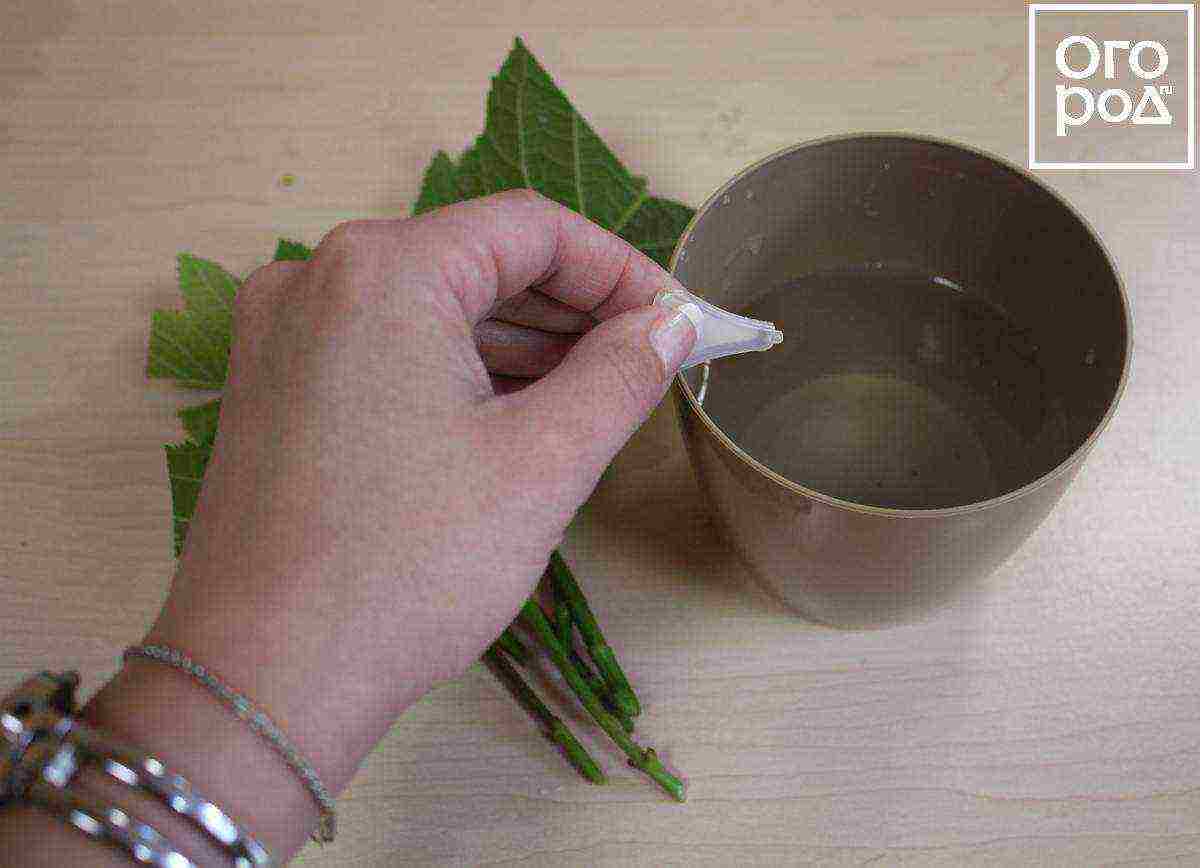
Then dust the lower cut with a rooting stimulator in the form of a powder or granules (for example, Kornevin).

How to root hydrangea cuttings?
In addition to the cuttings themselves, prepare in advance the container, substrate and water (in a watering can and a spray bottle).

For rooting hydrangeas, a mixture of coarse sand and peat in a 1: 2 ratio is suitable.
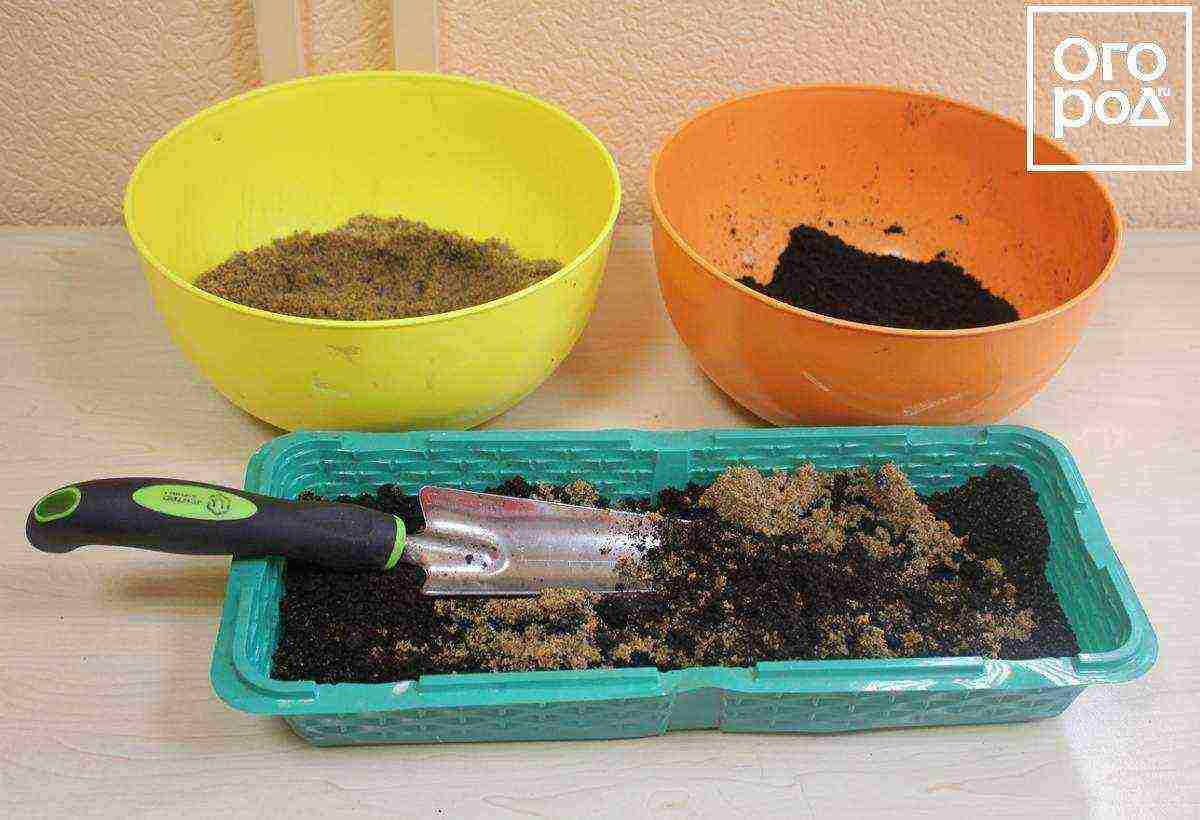
The soil mixture is moistened and leveled.
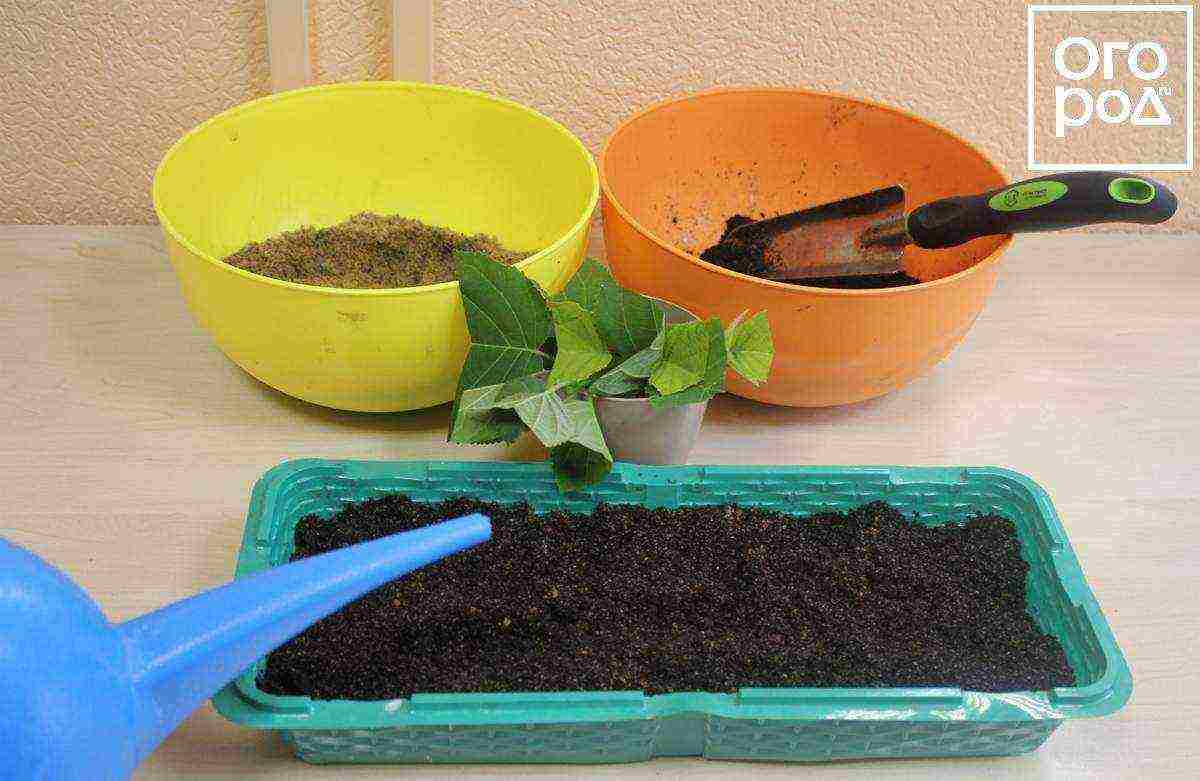
Then the surface of the soil is sprinkled with wet sand (with a layer of 2 cm).

Hydrangea cuttings are planted to a depth of 2-3 cm.
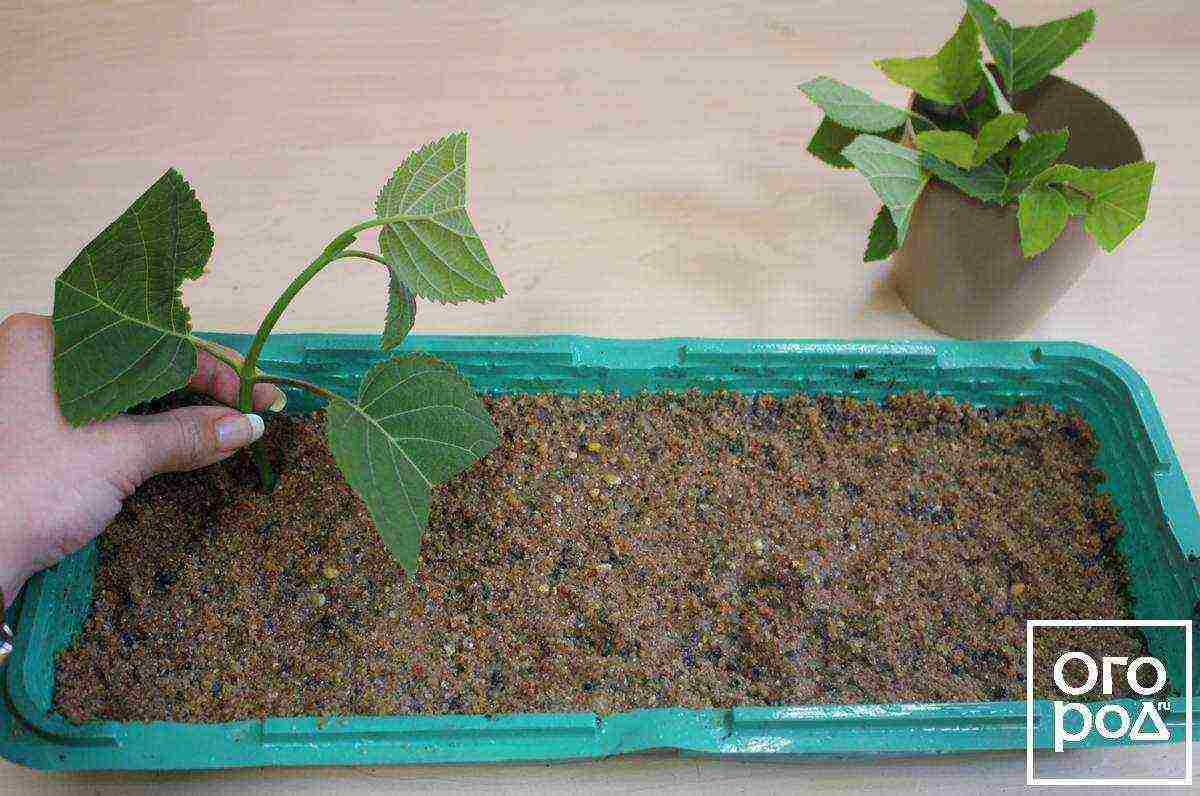
The distance between them should be such that the leaves of the cuttings do not touch each other. Usually it is at least 5 cm.
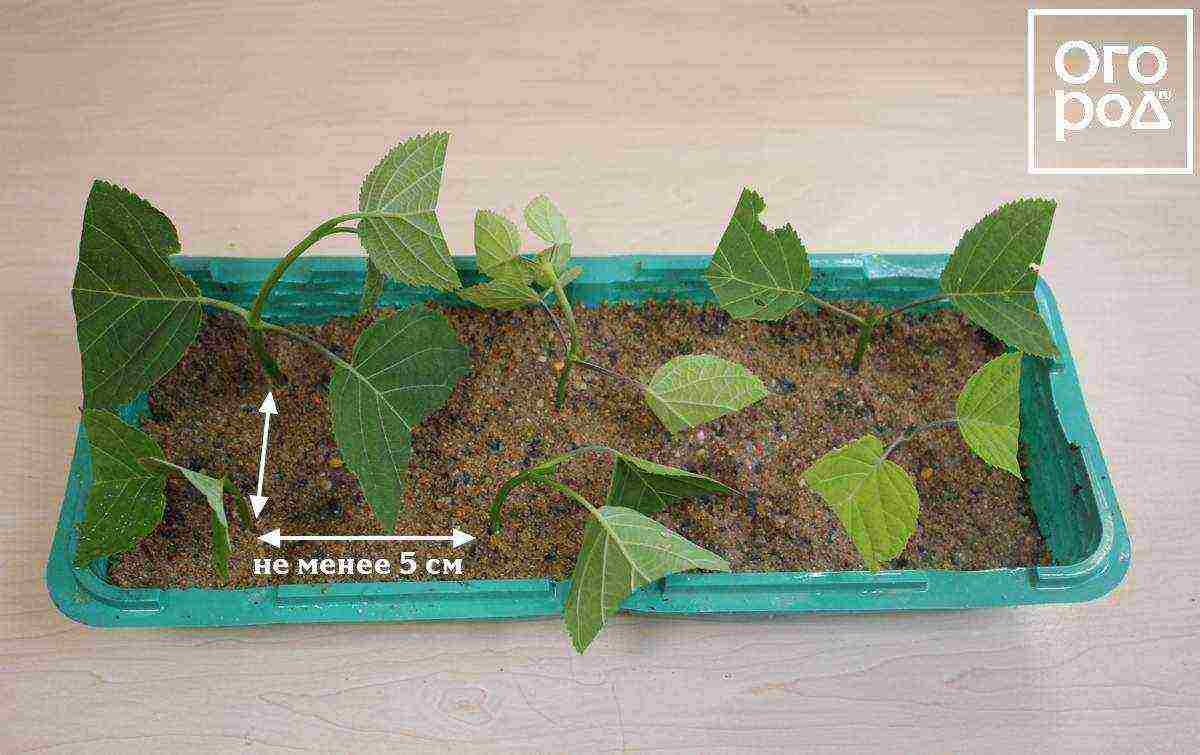
The cuttings are sprayed with clean water using a spray bottle.
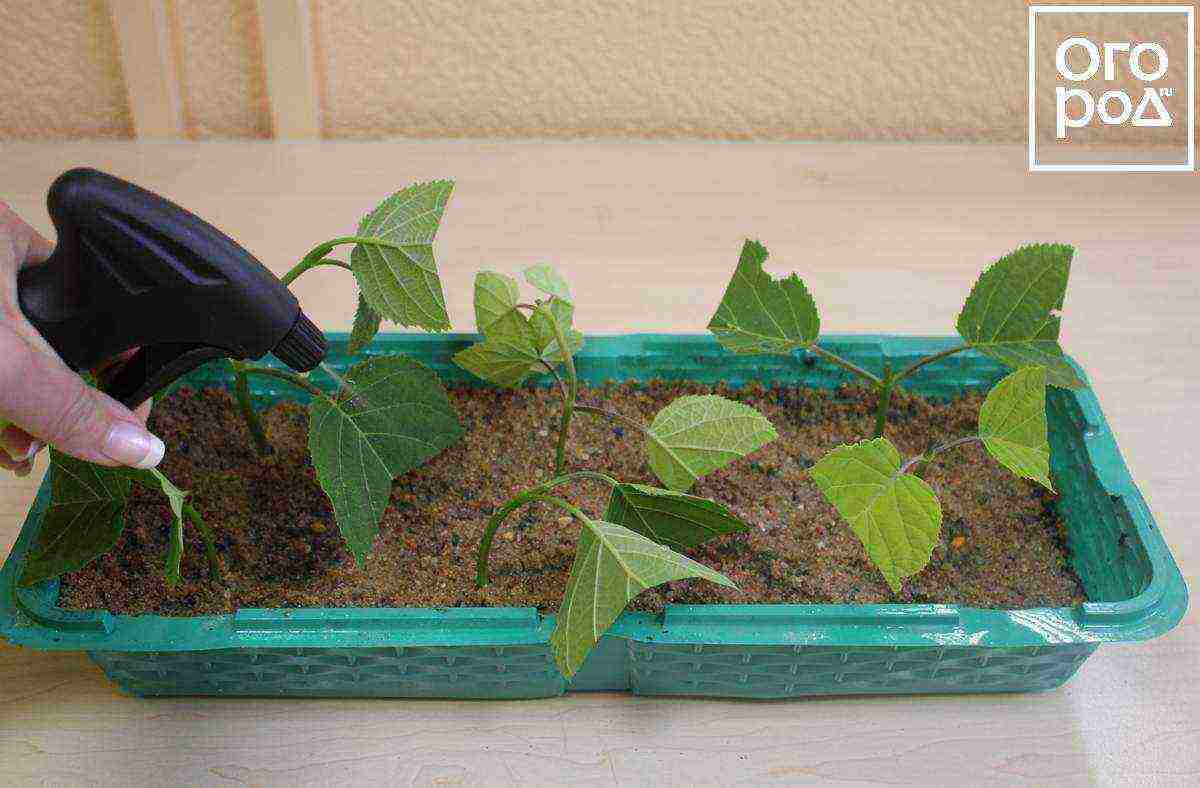
Then cover with a plastic bag or glass or plastic cap (you can use a cut bottle).
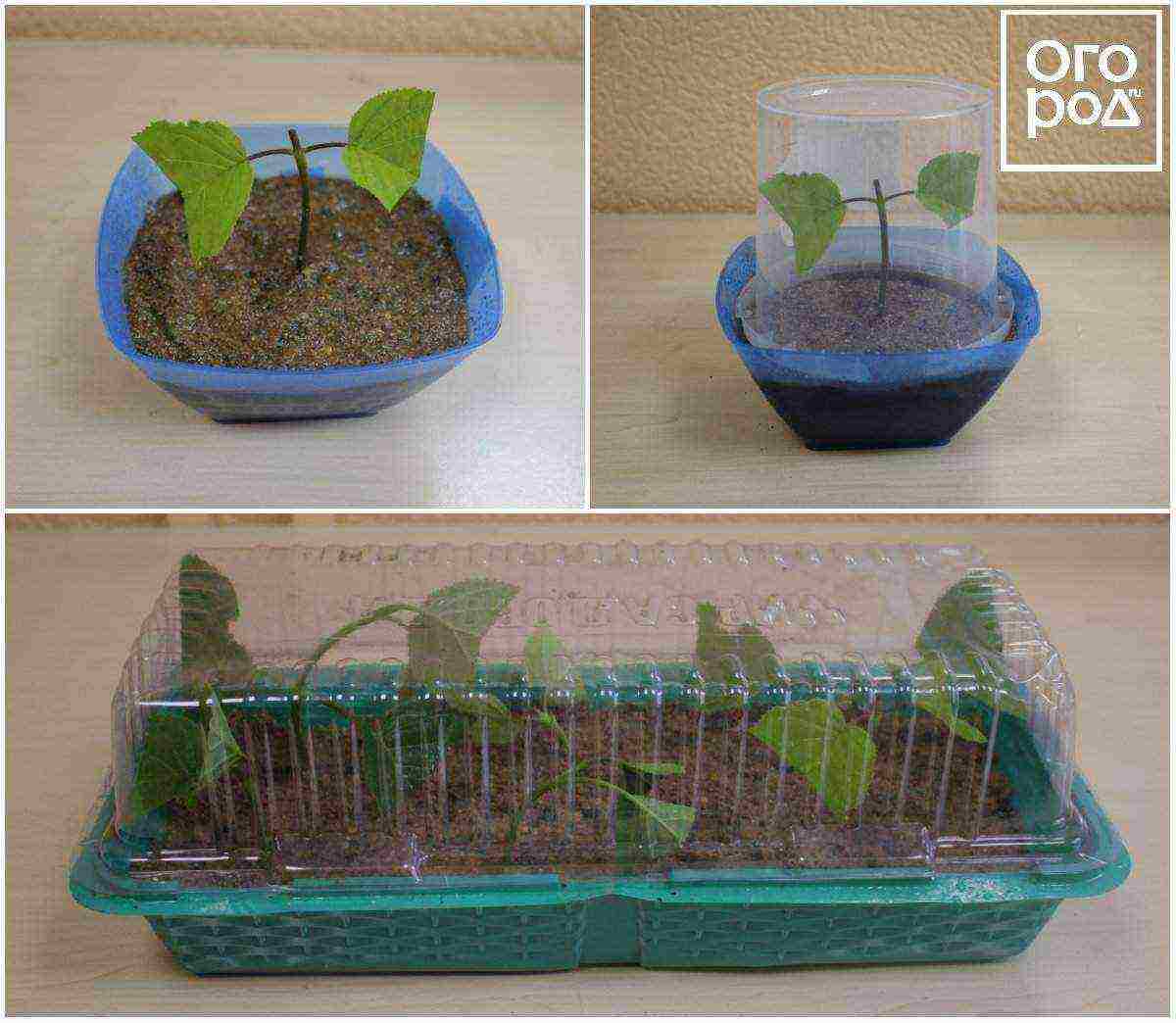
The container is placed in a warm and shaded place. The cuttings are watered regularly: at least once a week, and in the heat - every day. The optimum air temperature is 18-25 ° С. In such conditions, cuttings of hydrangea take root after 3-4 weeks. The signal for this will be the appearance of new leaves on them.
Caring for cuttings after rooting
After the roots appear, the covering material is removed, the cuttings are planted in separate pots filled with a mixture of garden soil, peat and sand (in the ratio (2: 2: 1) and continue to grow in a shady place. Do not forget to water regularly.
In a permanent place, a hydrangea grown from a cuttings is planted only next spring, and it is pre-hardened on the balcony. In addition, if the plant is frail, it is better to first settle it in a school garden until it gets stronger.
Treelike and large-leaved hydrangeas can also be propagated by semi-lignified and lignified shoots (in spring and autumn). And only green cuttings, which are cut in summer, are suitable for cutting paniculate hydrangea. Hurry up before the plant blooms!
Loading …
Hydrangea is a beautiful shrub with lush foliage and multi-colored caps-inflorescences. Many amateur flower growers, having seen this blooming beauty at least once, will no longer want to part with her. In order not to buy planting material, the plant can be propagated independently.
One way is propagation by cuttings. Its advantage is the complete preservation of all the decorative features of the species, as well as the ability to quickly grow a blooming young specimen. To propagate a hydrangea in this way, you will have to spend a little time and effort, as well as take into account some features and nuances. In this article, you will learn how to cut a hydrangea.
When can I cut a hydrangea
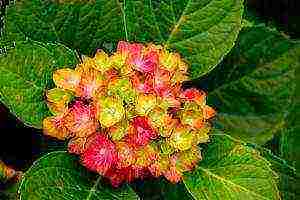 Cuttings of hydrangeas for the purpose of reproduction are carried out in spring, summer or autumn. In the first case, cutting is carried out before the start of sap flow at the plant - in March.
Cuttings of hydrangeas for the purpose of reproduction are carried out in spring, summer or autumn. In the first case, cutting is carried out before the start of sap flow at the plant - in March.
Lignified branches are taken, they can remain after the formative spring pruning. It is recommended to bring them into the house and leave them in a warm place for several days.
Propagation of hydrangea by cuttings in summer is best done in June-July.when young shoots have developed well and gained strength.
For propagation of hydrangeas, you should choose green cuttings or those in which only the lower part is lignified. Cuttings, which have the rudiments of buds, take root well.
Other breeding methods for indoor and garden hydrangeas can be found here.
Pruning cuttings and treating them with a stimulant
An important point for successful propagation by cuttings is the preservation of moisture in the shoots. Therefore, the best time for slicing is early morning. It is necessary to cut off the very top of the shoot, which has 2-4 pairs of leaves. The strongest, healthiest branches should be selected without any defects. The cut is made at a 45˚ angle directly below the lower knot.
 The bottom two sheets should be completely removed. The rest of the leaf plates are cut in half.
The bottom two sheets should be completely removed. The rest of the leaf plates are cut in half.
If the plant propagates in early spring, then the cut branches are kept in a warm place in water for 3-5 days. Then they should be cut into several parts, while each of them should have 3-5 buds.
Not every prepared cutting of hydrangea takes root well and grows, therefore it is recommended to treat cuttings with stimulants, which contribute to the rooting and rapid growth of young specimens.
Prepared cuttings are soaked for 10-12 hours in Epin's solution in a proportion of 2 ml per 2 liters of water. Another option is HB101 solution, at the rate of 1-2 drops per 1 liter of water. In this case, the soaking time is reduced to 30 minutes.
Finally, the lower part of the cutting, including the first internode, is dipped in Kornevin or Ukorenit powder to stimulate root formation. Then the cutting is planted in the ground.
How to root a hydrangea with cuttings
It is important to consider that propagating hydrangea by cuttings (it does not matter, in spring or summer) is not a quick matter that requires patience. Before starting the treatment of cuttings with root formation stimulants, the soil should be prepared for planting. There are different composition options. The most common ones are:
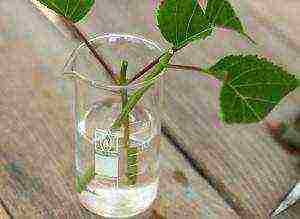 A mixture of turf, peat and sand in a ratio of 1: 3: 4;
A mixture of turf, peat and sand in a ratio of 1: 3: 4;- Washed river coarse sand;
- A mixture of sand and peat in a 1: 2 ratio, on top of the substrate there is a 2 cm layer of sand.
Before planting, the substrate is treated with steam for disinfection.
Cuttings should be planted in the ground at an angle of 45˚, buried by about 2-3 cm. They should not touch each other, and their leaves should not touch the sand.
Another way to root cuttings is in water. The water is settled in advance for 2-3 days to remove calcium salts from it. When the length of the roots reaches 2-3 cm, the cuttings are planted in the ground. The water in the glass should be changed every other day to avoid rotting of the cuttings.
Caring for planted cuttings
Immediately after planting, it is recommended to spray the cuttings with settled water from a fine-grained spray bottle. It is also necessary to organize a small greenhouse.
 For this, the container with the planted cuttings is covered with a transparent plastic bag or glass jar and placed in a shaded place. This will protect the cuttings from overheating and drying out.
For this, the container with the planted cuttings is covered with a transparent plastic bag or glass jar and placed in a shaded place. This will protect the cuttings from overheating and drying out.
The greenhouse needs aeration every day. Watering should be done as needed - about 1-2 times every 10 days. If it's summer outside, containers with cuttings can be taken out into the fresh air in the garden.
The main condition is that the ambient temperature should be in the range of 20-25˚ during the day and 15-18˚ at night. When such favorable conditions are created, the roots of the cuttings should appear within a month.
Planting in a pot
 When the cuttings take root and they have 1-2 new young leaves, the shelter is removed.
When the cuttings take root and they have 1-2 new young leaves, the shelter is removed.
After a week or two, each of the cuttings can be transplanted into individual pots. They should be shallow, about 10 cm in diameter and height.
The soil for young plants needs nutritious and light... You can buy ready-made substrate in the store or prepare the mixture yourself. To do this, you should take peat, river sand and garden soil in a ratio of 2: 1: 2.
Immediately after planting, young specimens are recommended to be kept in a shaded place. Watering should remain regular.
It is possible to plant a hydrangea in open ground only next spring.
Landing in the garden
For the winter, young specimens of hydrangea can be dug into the ground directly in pots so that their root system does not freeze. In this case, they should be carefully covered, for example, with fallen leaves. Another option is to place containers with cuttings in a basement with a temperature of 1-5˚, only after the leaves have fallen off. Watering stops completely.
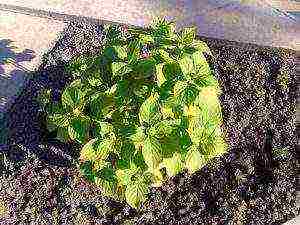 In the spring, when the first signs of growth appear, watering is gradually restored.
In the spring, when the first signs of growth appear, watering is gradually restored.
When the threat of frost passes, young plants are planted in open ground either to a permanent place or to a “school” bed for another 1 year.
Before planting, the earth is well dug... Add 1 tablespoon of universal mineral dressing to each well. Hydrangea is planted with a clod of earth.
In order not to damage the root system, watering is not done for several days before transplanting. Thanks to this, the hydrangea is much easier to get out of the pot along with the soil. To get a lush bush, after transplanting, it is recommended to cut the seedling by 2/3 of its height.
Features of the reproduction of hydrangeas by species
The main feature when graftinglarge-leaved hydrangea, is its low cold resistance compared to other species. The basic principles of its reproduction are the same as described above.
However, it reproduces exclusively by non-lignified cuttings of the current year. The optimal time for this is from June to September. Only apical cuttings should be selected. For the winter, not only young specimens of this species take refuge, but also adults, in order to avoid freezing.
Cuttings panicle hydrangea it is carried out only in summer, when the shoots contain a lot of moisture, and the leaves do not evaporate much. This is roughly mid to late June.
How to cut a panicle hydrangea - cuttings are recommended to be taken from the bottom of the bush. In this case, they are not cut off, but broken off together with the "heel". The lower leaves are removed and the rest are not shortened. Then the cuttings are planted either in pots or in open ground. Otherwise, the breeding technology does not differ from the standard one.
If buds appear on the bush in the first year of life, it is better to remove them. This will help strengthen the root system. For the winter, young specimens take refuge only for the first few years of life.
Feature when graftingtree hydrangea, is the possibility of rooting its cuttings not only in spring and summer, but also in autumn. In this case, the process of rooting and growing young specimens is carried out at home in pots.
The basics of caring for hydrangea in the garden
 When you know how to propagate hydrangea by cuttings, it is important to follow the rules for caring for the plant correctly.
When you know how to propagate hydrangea by cuttings, it is important to follow the rules for caring for the plant correctly.
Hydrangea is a light-loving plant. Therefore, the most suitable place for her would be a sunny place, but at the same time protected from cold winds and drafts.
Also, the plant loves moisture. It should be watered abundantly and regularly, especially on hot summer days. The soil must not be allowed to dry out.
In addition, hydrangea is demanding on the composition of the soil. It will grow well in nutritious acidic or slightly acidic soils that are good for water and air permeability.
Sand, from which nutrients are quickly washed out, or soil with lime impurities is completely unsuitable for it.
For good growth and abundant flowering, hydrangeas need regular feeding. From early spring to the end of July, it needs mineral fertilizers twice a month and organic fertilizers once a month.
For the winter, hydrangea bushes are covered with spruce branches or fallen leaves, since they are not very cold-resistant and can freeze slightly. Pruning is done in the spring to stimulate flowering and form a lush bush. The tops of the shoots are trimmed so that 3-4 flower buds remain on each of them.
Knowing how to grow a hydrangea from a cutting, you can grow a gorgeous lush bush that will delight for a long time with multi-colored large caps-inflorescences!
You can read about caring for indoor hydrangea here.
Large caps of flowers - panicle hydrangea inflorescences - attract the attention of many. Such a charming bush in the garden can be a source of pride and admiration. Therefore, the question of how to reproduce hydrangeas by cuttings on their own is of particular relevance. To begin with, we suggest that you study the general recommendations on how to prepare material for planting, and the algorithm of actions.
What is the timing of hydrangea cuttings?
Vegetative propagation can be carried out in three stages: spring, summer and autumn. In the first case, it is necessary to start even before the sap flow in plants begins. Take lignified branches from the bush. As a rule, they remain after formative pruning - and you have done a useful job, and propagate the hydrangea. Bring them home, warm, and let stand in the water for a few days.
The propagation of hydrangea by cuttings in the summer can begin from June-July, when the shoots of the current year are already well developed and have gained strength. Choose those that have not had time to woody and have not yet bloomed.
Harvesting cuttings: technology
- You need to cut off the very top of the shoot, which has 2-3 pairs of leaves. Choose the healthiest specimens. The cut is made under the lowest pair of leaves. Observe an angle of 45 °.
- Then you need to cut off the bottom pair of leaves completely together with the petioles, and cut off the plate in half for the rest.
- In the event that the propagation of hydrangeas by cuttings occurs in early spring, the prepared branches, after being kept in water for 3-5 days, must be cut into several parts so that each has 3-5 buds.
Processing cuttings
Not every hydrangea garden propagation by cuttings tolerates easily and simply, and therefore treatment with special preparations is desirable. However, this step is, in principle, advisory in nature, but improves the chances of rooting and the rapid growth of new plants. Prepared cuttings of hydrangea (regardless of the season) should be soaked in a weak solution of the Epin preparation (at a concentration of 2 ml per 2 l of water) for 10-12 hours, or use HB101 (1-2 drops per 1 l of water) and cut time up to 30 minutes. At the end of the procedure, you should use the powder "Kornevin" or "Ukorenit", which stimulates the formation of roots. To do this, simply dip the cuttings in powder up to the first internode from which the leaves are cut. Then start planting immediately.
Rooting process
Keep in mind that propagating hydrangeas with green cuttings or spring cuttings is a rather long process and requires patience. Before starting the treatment with root growth stimulants, you need to prepare the soil. You can find a lot of recommendations for its preparation, and the component composition is quite different. We recommend using the usual washed coarse-grained river sand. Plant the cuttings at an angle of 45 °, while immersing the lower part by about 2-3 cm.At the same time, make sure that they do not touch each other, and the remaining leaves - sand. After planting, lightly spray the cuttings on top with water from a spray bottle.
Organize a small greenhouse for them, cover it with either a glass jar or polyethylene, and put it in a shaded place, this will save them from overheating and drying out. If hydrangea propagation is carried out by cuttings in the summer, then you can take them out to the garden or greenhouse. The main thing is that the temperature is within + 20-25 ° С during the day and + 15-18 ° С at night. If these conditions are met, the roots appear in about a month.
Seedling care
As soon as the roots on the cuttings reach 2-3 cm in length, you can plant them in separate pots. Large crockery is not required, a diameter of 10 cm and the same depth is sufficient. The soil for young hydrangeas should be light and nutritious. You can buy suitable land in a specialized store, or you can make it yourself. For an optimal soil composition, you will need to mix peat, ordinary garden soil and river sand in a 2: 2: 1 ratio. For the first time, keep the seedlings in a shaded place and do not forget about regular watering. Propagation of hydrangeas by cuttings is not a quick process; young specimens will be ready for planting in open ground only next spring.
Planting seedlings in open ground
For the winter, young seedlings must be dug into the ground right in the pot so that the root system does not freeze.Or, after the leaves fall, stop watering completely and place the plants in the basement, where the temperature is kept within + 1-5 ° C. In the spring, when signs of growth are visible, start watering the plants gradually and then plant them in the ground. You can immediately choose a permanent place on the site, or organize a small garden bed - "school" and hold them for another year on it.
Dig up the soil well before planting. It is advisable to add 1 tbsp to each hole. l. universal mineral fertilizer. Plant the hydrangea with a clod of earth. In order to get it out of the pot without any problems, do not water the plant for 2-3 days. Sometimes, to get a lush bush immediately after planting, it is recommended to cut the seedling by 2/3 of the height.
Large-leaved hydrangea: propagation by cuttings
The basic principles of reproduction of this species are those that were named above. However, the plant has a capricious character, therefore, when cutting it, you need to know some subtleties. First, the large-leaved hydrangea reproduces only by green summer cuttings and by dividing the bush. The most suitable dates are June - September. Choose a not too hot, cloudy day for the procedure and cut the apical cuttings with a sharp knife. You can, of course, take from the middle of the shoot, but, as practice shows, they develop more slowly and worse. The further algorithm of actions is similar to that described above. Do not forget to cover for the winter not only a young large-leaved hydrangea, but also an adult, since it is very sensitive to cold weather.
Hydrangea paniculata: propagation by cuttings
The terms for grafting in this species are very short, so it is important not to miscalculate, otherwise rooting is very often unsuccessful. The ideal moment is when the shoots already contain enough moisture, and young leaves do not evaporate it so quickly. In Central Russia, it falls around the middle of June. Take cuttings at the bottom of the trunks, without flower buds. It is recommended not to cut them off with a secateurs or a knife, but to pinch them off together with the so-called "heel" up to 1.5 cm long. ). Next, the cuttings are planted either in open ground, on a prepared bed in advance, or in separate pots. Such cultivation features have a panicle hydrangea. Reproduction by cuttings in water is ineffective. If peduncles appear on a young plant in the first year, then it is better to remove them so that the plant will put all its strength into the growth of the root system. Young plants after planting in the ground in the first couple of years should be covered for the winter with spruce branches or special material.
A few words about other breeding methods
Not every hydrangea garden propagation by cuttings is successful, so it makes sense to think about other ways to get a new plant from the mother.
First, layering. The optimal time is early spring, when the buds have already swollen, but have not yet begun to bloom. Near the bush, you need to dig up the soil and level its surface. Shallow grooves (1.5-2 cm) are made to the sides in a circle, then the lower shoots are laid in them. To prevent the branches from straightening, use metal arcs (they will gently press them to the ground), and sprinkle a little soil on top. Towards the end of summer, several shoots are formed on each layer. When they reach 15-20 cm in height, you need to gradually huddle them at intervals of 7-10 days. Separation of cuttings is carried out in October, after which the seedlings must be dug into the ground.
If the propagation of hydrangeas by cuttings is possible at any stage of the development of the bush and in a long time period, then it is best to do this with shoots when transplanting the mother plant. Some species, under favorable conditions, form a lot of root growth, which is simply necessary to separate.In spring or autumn, around the mother bush, it is necessary to carefully remove the top layer of soil, carefully separate the daughter shoot and plant it in a permanent place. Caring for him is the same as for an adult plant.
Planting garden hydrangeas and care have their own characteristics. To admire the beautiful and lush flowering, we will learn how to properly care for this plant.
Garden hydrangea - species and varieties
There are many types and varieties of this ornamental shrub. Most of them prefer to grow in partial shade, but there are some that do well in sunny areas. The height of the bushes and the flowering period are very different and depend on the variety.
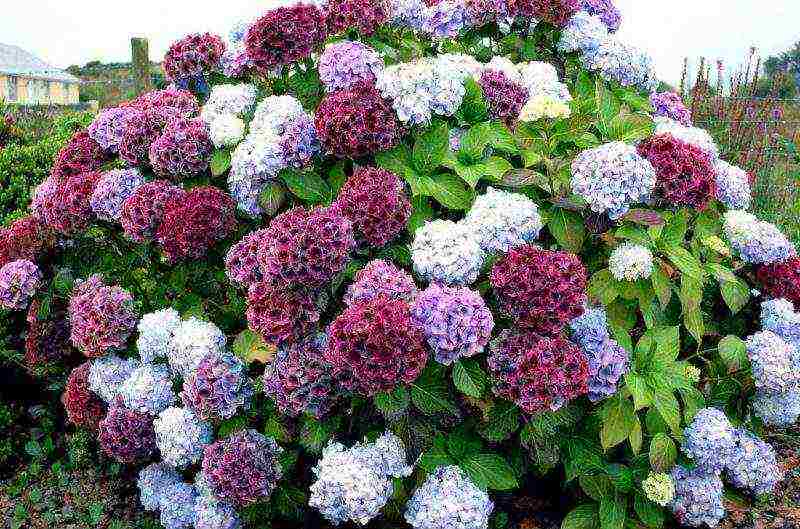
The most common types:
- Large-leaved. It blooms in the second half of summer with lush inflorescences in the form of balls. Flowers can have a different shade. Height - 2 m.Requires shelter in winter, maximum tolerates temperatures up to - 10 ° C
- Pereshkovaya. Variety of creepers. It blooms with white-pink inflorescences. Requires support, otherwise it will creep along the ground. A good option for arbors and arches.
- Tree-like. The flowers are snow-white. Height - up to 3 m. It looks very impressive, but freezes in winter. The plus is that the plant recovers quickly. Requires strong spring pruning.
- Paniculata. It blooms from July to late autumn with dense panicles 30 cm long. The shade of the inflorescences varies from white to greenish. The height of the bush is 3-4 m. An unpretentious and frost-resistant variety.
On the basis of these species, many different varieties have been created, each of which is beautiful in its own way. Depending on the type, hydrangeas can be deciduous or evergreen, but in our area they are most often grown in the first version.
Growing features
Interestingly, the shade of the inflorescences can be adjusted independently by adding certain fertilizers to the soil. On neutral soil, the flowers will have a beige or cream shade. A soil with a high alkali content gives flowers a pink or lilac color, acids - a blue one.
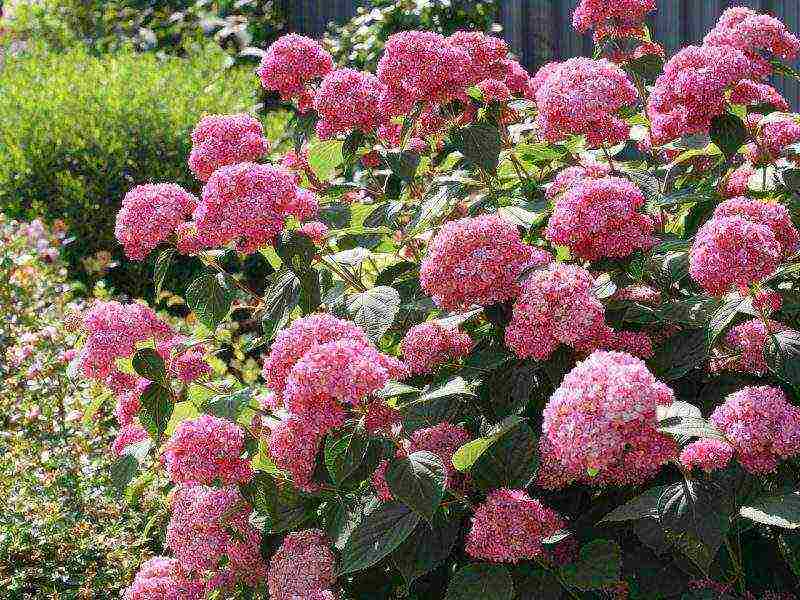
Bright lighting is very important for the shrub, but the scorching rays of the sun are destructive for it, as well as deep shadow. Therefore, it is best to plant a flower where there is shade at lunchtime, and the rest of the time - the sun.
It is important not to overfeed the seedlings with organic matter. They will grow green mass, but are unlikely to bloom.
Landing in open ground

Hydrangea is a demanding flower. Therefore, before landing, you need to think carefully about all the nuances.
Site and soil preparation
The landing site must be prepared in advance - about 2 weeks in advance. The soil should be acidic and well moisturized. Acidity can be adjusted independently with the help of special preparations. Depending on the variety, the flowers can grow in partial shade or in the sun. The best place for planting is light partial shade; in a strong shade, the plants will not bloom.
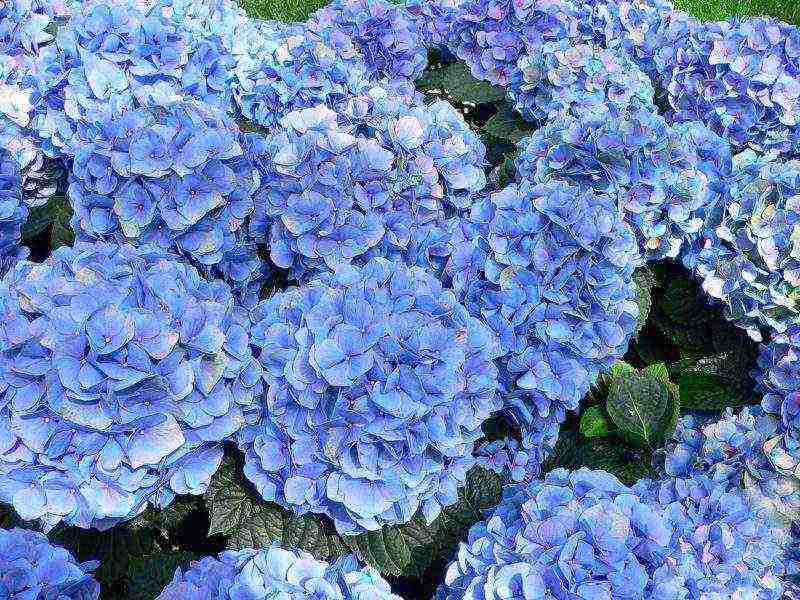
The hole should be small: 40 cm deep and 40 cm wide. If a group planting is planned, then the distance between the bushes should be at least 90-100 cm. Sand and fertilizers are added to the pit, mixing well with the ground. The next layer is poured a little peat.
How and when to plant?
Planting is done in early spring or autumn. It depends on the climate of each region. In cold areas, it is better to plant the bushes in the spring so that they can give new roots, get stronger and be able to survive the harsh winter. In warmer regions, planting can be done in the fall. If planting is done in spring, then annual shoots should be shortened by at least 3 buds.
It is advisable to shorten the roots of the seedling a little. When planting, you need to make sure that the root collar is not covered with earth. The planted bush is abundantly watered and mulched with peat. When watering, care must be taken that a strong jet of water does not erode the soil near the roots.
As soon as new leaves appear on the plant, this indicates that the process of the formation of new roots is in full swing.
Phantom hydrangea care
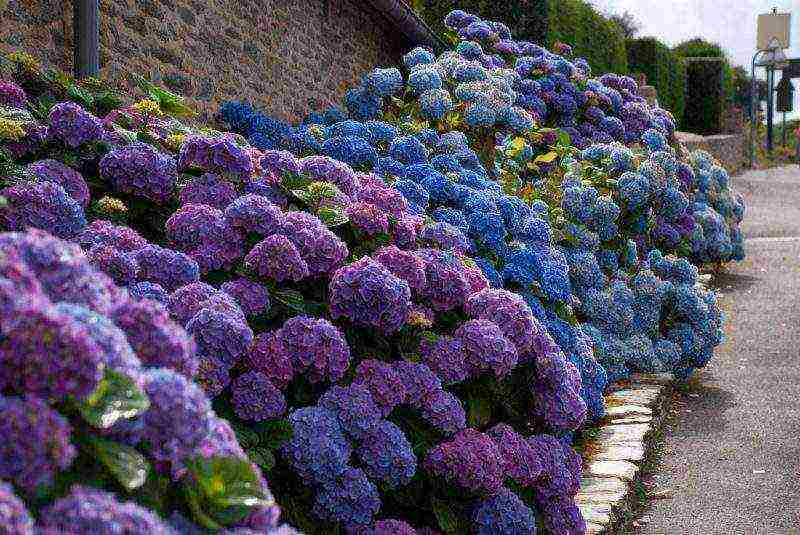
Hydrangea Phantom is one of the most beautiful of the paniculata family.It blooms magnificently throughout the season with long panicles and exudes a pleasant aroma. The variety is resistant to root diseases and frost, quickly recovers after freezing. The bush can grow in one place for many years without requiring a transplant.
Watering and feeding
"Hydrangea" translated from Latin means "yearning for water." The flower is very hygrophilous, therefore, in no case should the soil dry out. Watering should be regular and abundant. As soon as the topsoil dries a little, the plant needs to be watered again. If the ground around the bush is mulched with peat, you can water less often, since the soil does not dry out so quickly. In the first years, 7-8 liters of water are poured under each seedling, in subsequent years - at least 18 liters.
Watering is the best time to feed. In early spring, the plant needs nitrogen fertilization, during the budding period - in potassium and phosphorus.
It is useful to water the bushes with acidified water once every 2 weeks. For 10 liters of water, you need to take 1 tbsp. l. citric acid. The solution is poured directly under the roots. In addition, in the spring-summer period, once every 3-4 weeks, you need to loosen the ground in order to improve aeration.
How to transplant and prune?
The plant tolerates pruning well. If you do not cut it, the bush will lose its decorative effect, and the flowering will be weak. It is best to do this procedure in the spring, when the buds are swollen. If the bushes are too old, they can be easily renewed by cutting them almost to the root.
All types of hydrangeas can be divided into two groups:
- To the first category includes those species and varieties, the flowers of which are formed on the shoots of the last year (petiole, prickly, large-leaved, serrate). They do not need special pruning, it is enough to remove old, dried and improperly growing branches.
- To the second category includes species that form flowers on the shoots of the current year (paniculate and tree-like). These bushes require strong pruning, all shoots should be shortened in early spring to 2-3 pairs of buds.
When the hydrangea is going to bloom for the first time, you need to immediately cut off all the buds so that the plant gains strength and can bloom profusely next year. Formative pruning of the bush within 5 years will produce a beautiful little tree.
It is necessary to transplant Phantom hydrangea only in extreme cases. It grows well in the same place for years. Therefore, the transplant is justified if an adult bush needs to be divided into parts and transplanted in other places.
Flower care in autumn

Garden hydrangea care in autumn consists in pruning the inflorescences, while removing at least 3 buds from the top of the shoot. This must be done so that suddenly falling wet snow does not freeze on them and break fragile branches. The base of the bushes must be huddled high, and the ground around them must be well mulched. This will protect the superficial root system from frost.
How does hydrangea winter?
In the middle lane, the shrub tolerates winter well. But for a safety net, it is still better to cover it with spruce branches. In the northern regions, the flower is taken to a room with a positive temperature for the winter, since severe frosts can destroy it.
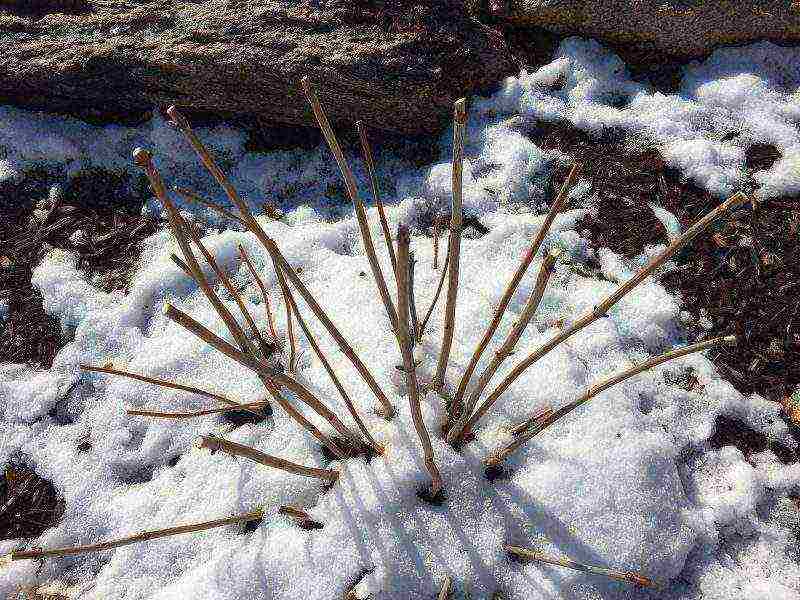
Sometimes the bushes are neatly tied up, wrapped in spunbond and a mesh frame is erected near them. The space between the covering material and the mesh is filled with dry foliage. With the first breeze of heat, the leaves are removed, but the spunbond is removed only after a constant positive temperature is established.
How does garden hydrangea reproduce?
The easiest way to propagate a hydrangea is cuttings. They are cut in the spring from annual green shoots. It is necessary to cut at right angles. The length of the cuttings is no more than 12 cm. Leaves are removed from the bottom, treated with preparations to stimulate growth and planted in a greenhouse or boxes.
A good option is to multiply the flower by dividing it. This can be done both in spring and autumn. The bush is carefully dug up and divided into 3-4 parts, so that each one has several renewal buds.The workpieces are planted in pre-marked places.
Also, without much effort, you can propagate the hydrangea by layering. Young shoots are gently bent to the ground, fixed and buried in the ground, leaving the top (about 20 cm). As early as the next spring or autumn, the root cuttings can be separated from the mother plant and transplanted.
Sometimes the shrub is propagated by seeds or grafting, but these are too laborious methods. Knowing how the garden hydrangea reproduces, you can choose the appropriate method in advance and do it in a timely manner.
Protection against diseases and pests
Hydrangeas rarely get sick, while the lion's share of the disease is transferred with seedlings. For this reason, you only need to buy new plants from proven nurseries. Other causes of diseases are called thickening of plantings, lack of nutrients and high humidity.
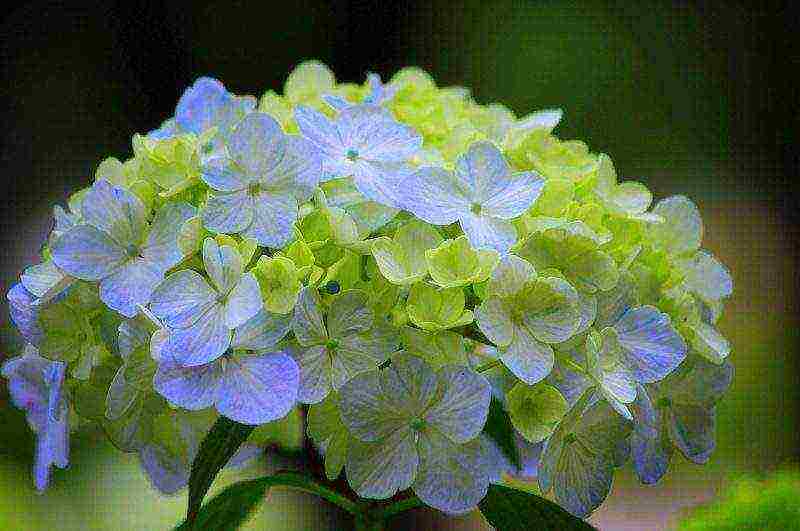
Many fungal diseases can be fought with copper oxychloride.
One of the most common diseases is chlorosis. Due to the lack of iron, the leaves turn yellow, while the veins remain green. For treatment, drugs Agricol, Brexil are used. As a preventive measure, plants need to be fed with iron-containing fertilizers in a timely manner.
Use in landscape design
Hydrangea looks great both in single plantings and in group plantings. You just need to design in advance its location at a decent distance from other plants. Over time, the bushes grow strongly and require a lot of space.
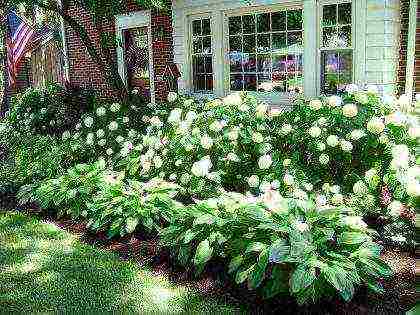
The flower can be planted as a soloist in the front garden if it is located on the north side of the house. When choosing hydrangea companions in a mixborder, you need to take into account their characteristics. Similar requirements for moisture, lighting and soil acidity in astilba, hosts, cuffs. If the site is large, you can plant a composition of several bushes. Their sprawling shape will create an expressive accent in the garden. These shrubs are often used to restrict areas of the garden.
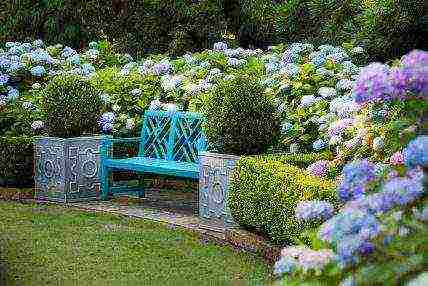
Hydrangeas work well with a variety of garden styles, so anyone can grow them.
Hydrangea, or hydrangea, belongs to the hydrangea family. This vast family includes up to one hundred plant species. It includes both deciduous and evergreen plants. There are frost-resistant species here, and there are thermophilic ones. There are quite large representatives, and there are dwarf ones. This means that any gardener will find a hydrangea to his heart.
The homeland of the plant is the Far East, China, Japan. Hydrangea got its name from the Greek words: water and vessel. This is inherent in another less common name for hydrangea - hydranta ("hydra" means "water"). The shrub, whose name is found in descriptions of old parks, is now in vogue again, thanks to the abundance of hybrid varieties.
Description of hydrangea
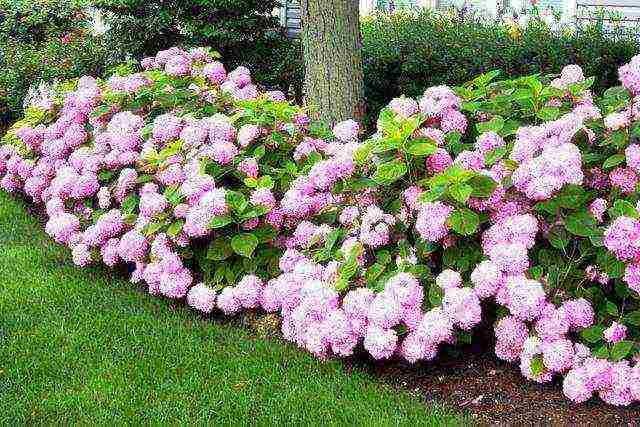
Hydrangea in landscape design photo
The most common hydrangea is a deciduous, beautifully flowering shrub. Leaves are opposite, petiolate, simple, with denticles along the edge, rather large. The flowers are small, collected in inflorescences in the form of panicles, umbrellas and balls located at the ends of the branches.
The flowers are white, blue, pink, lilac, purple or reddening. In the center there are flowers from which seeds are formed, and the outer ones with four petals are decorative. In floriculture, the following are often used: panicle hydrangea (garden) and hybrid hydrangea.
The hydrangea has an interesting property: the color of flowers of one variety changes depending on the level of acidity of the soil.
How to care for hydrangea in the garden
Hydrangea loves frequent, abundant watering. In dry hot weather, the plant is watered almost daily. In order for the soil under the bush to dry out more slowly, it is mulched with sawdust, wood chips, humus from the leaves. For hydrangeas, mulching with spruce and pine needles is preferable, since the plant loves acidic soil.
The ideal place for a hydrangea in the garden would be one that is located in the shade of large trees (walnut, catalpa, maple, linden) or near a fence where there is shade. A small number of plant species grow in an open, sunny area.
Hydrangea responds positively to frequent feeding. They contribute to the growth of the bush, its abundant flowering. For feeding, they use balanced complex preparations that are sold in the store. But organic fertilizers in combination with watering with acidified water are also suitable.
The soil for planting a bush is chosen fertile, loose, drained. It should be acidic or neutral (this can be checked with an acidity indicator). Planting the bush in alkaline soil will result in poor growth due to lack of iron. To solve this problem, artificially acidify the soil or dig a hole for planting and fill it with acidic soil. Hydrangia is also grown in separate containers (pot, barrel, tub).
Hydrangea usually tolerates low temperatures. But some varieties need to be covered for the winter, and some breeding varieties hibernate only indoors.
How to plant hydrangea outdoors

Planting hydrangeas in open ground photo of seedlings
When to Plant or Transplant Hydrangea? Spring is considered the best time to plant a bush. By the fall, the plant will take root, grow the root mass. But if you missed the spring planting time, you can transplant the bush in the fall.
Both single hydrangea bushes and groups are planted. For a single planting, a square hole is dug on the long side of 59-70 cm and a depth of 40-45 cm. For group planting, in order to form a hedge, the plants are planted at a distance of 1.5-2.5 m. The main criterion is the hydrangea variety. An important rule is that the volume of the planting pit is not less than the volume of the crown of the plant.
To transplant an adult plant (from 4 years old or more), they dig a planting hole with a depth of at least half a meter. At the same time, it is taken into account that the bush will grow comfortably if the distance from its center to neighboring plants is one meter.
When transplanting, the soil is enriched with the following additives:
- urea;
- leafy earth, humus, compost;
- potassium sulfate, colloidal sulfur to increase acidity;
- superphosphate.
After transplanting, the plant is not fed for two seasons, and then the feeding is resumed up to 3-4 times during the spring and summer.
Feeding hydrangeas
How to feed hydrangea in spring
In early spring, as soon as the buds begin to bloom, feed the hydrangea with nitrogen and potassium. This will allow the plant to actively grow green mass and bloom more actively.
We take:
- a tablespoon of urea or saltpeter
- a tablespoon of potassium sulfate
This mixture is diluted in 10 liters of water and consumed per square meter.
Lovers of natural fertilizers can be advised to use fermented slurry diluted with water. As usual, the concentration is 1:10. We also water: a bucket per m2 of area.
A barely pink solution of potassium permanganate is used three times per season, and feeding is useful not only for the roots: you can douse the plant from above to process all the green mass.
How to feed hydrangea in summer
Abundant flowering all season is a good load for any plant. Therefore, gardeners need to support the beauty with complex fertilizers, for example, "Kemira blooming" will provide all the necessary substances for hydrangeas.
The same organic matter will not be superfluous: slurry and bird droppings. Poultry droppings are diluted even more, since the nitrogen concentration there is much higher. Therefore, ferment the droppings first for two weeks and use a 0.5L can of concentrate in a bucket of water.
A good feeding of hydrangeas will be whey or yogurt containing lactic acid. However, you should not get carried away: 2-3 such dressings are enough for the entire season.
If you have any remaining pieces of bread or crackers, soak well in water and buried in the ground around the hydrangea.The beauty will not forget such a "dinner" and will thank you with beautiful flowers on strong branches.
How to feed hydrangea in autumn
Autumn feeding with potassium-phosphorus fertilizers will help to prepare for a successful wintering, to lay more flower buds.
We take:
- a tablespoon of potassium sulfate
- a tablespoon of superphosphate
We dilute the mixture in a bucket of water and pour 7 liters under each bush.
I would like to warn against the introduction of natural organic matter and nitrogen-containing mineral fertilizers in the fall: the hydrangea will begin to actively grow young branches, which will take away the strength from the plant and will not allow the existing branches to ripen. So the bush will become brittle and will not overwinter well.
The advice does not apply to already rotted humus, compost or fall leaves, where the nitrogen content is very low. Such mulching is even necessary to cover the hydrangea for the winter and prevent the roots from freezing.
How to propagate hydrangea
Hydrangea propagation methods are traditional: propagation by cuttings, layering and dividing the bush.
Propagation of hydrangea by cuttings video
Propagation of hydrangea by cuttings in summer
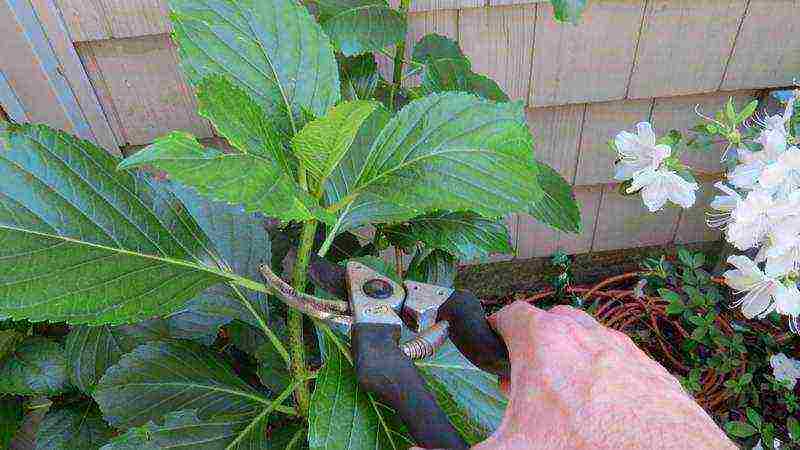
Cutting hydrangea in summer photo
- Green cuttings are cut in early summer from the apical shoots.
- Cuttings are planted in open ground in a shady place in loose light soil (a mixture of peat and coarse sand).
- Apply moderate watering. To reduce moisture evaporation, soil mulching is used between cuttings.
- Cut shoots are planted shallowly, obliquely, at a distance of 5-10 cm.
- After a month, the rooted plants are dug out with a clod of earth and planted in a permanent place.
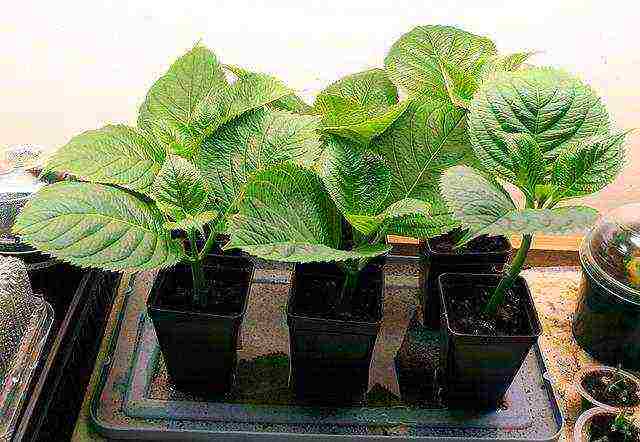
Hydrangea cuttings photo
Reproduction by layering
- To obtain cuttings in early spring, the lower branches are attached to the ground with wire rings and covered with fertile soil, with the exception of the top, which is fixed in a raised state.
- The next spring, the rooted layers are planted in a new place.
Dividing the bush
The division of the hydranthea bush is performed as needed at any time. To do this, they dig out a bush, divide it into parts, which are planted in the place of growth. It is important to divide the plant so that on each "beginner" 2-3 buds remain near the base of the stems, from which new shoots will form.
For breeding work, propagation methods are used: seeds and grafts. These methods are laborious and not widely used.
Hydrangea bloom
Surprisingly, hydrangea blooms all summer. At first, her inflorescences are green, then they are painted in different colors depending on the variety. Closer to autumn, the flowers fade, but do not fly around, but, gradually drying out, remain on the bush. But even dried inflorescences are beautiful.
Hydrangea differs from other shrubs by the simultaneous flowering of both male and female flowers. Hydrangea flowers are most often white or pink in color. Various shades of blue, purple, reddish can be seen on hybrid varieties. Abundant flowering of the bush is possible due to frequent feeding. They also contribute to the establishment of healthy buds for flowering in the next season.
Pruning a hydrangea or how to make a hydrangea bloom
The branches of the hydrangea are brittle. To enhance the strength of the shoots, watering with a solution of potassium permanganate is recommended. And so that the bush does not lose its decorative effect, it must be cut twice per season: in spring and autumn.
Spring video crop
Pruning time: before bud break.
Pruning procedure: remove frozen and broken shoots, thin branches that have not formed, shorten annual shoots to 4 buds.
The purpose of pruning: to reduce the amount of leaf mass, to promote abundant flowering of the shrub.
Pruning hydrangeas in the fall
Pruning terms: late autumn, after leaf fall.
The order of pruning: cutting off dried inflorescences, thinning the shrub.
The purpose of pruning: preparing for the winter so that the bush does not break from the weight of the snow.
There are also types of pruning - for rejuvenation of the bush and standard.To rejuvenate the old plant, you need to keep 3-7 of the strongest shoots, and remove all the rest by cutting them at the root. Already in the next season, the hydrangea will again become a lush and abundantly flowering bush. The standard form of hydrangea is rarely used and the goal here is to form a bush in the shape of a tree, leaving only one central shoot.
How hydrangea winters Shelter for the winter
Only thermophilic, hybrid varieties of hydrangeas need shelter for the winter. In order for them to endure the winter without loss, it is necessary to bend the shoots to the ground and carefully cover them with spruce branches and fallen leaves. If it is impossible to bend the branches, a "hut" of kraft paper, dense agrofibre or other insulation materials is built over the bush. For tree varieties, mulching of the soil around the plant is used as insulation. Mulch - fallen leaves of shrubs, peat, sawdust, spruce branches and more.
If a thermophilic variety grows in a separate container, foliage is expected to fall off and the container with a bush is transferred to a cool, damp room for the winter: a cellar or basement.
A plant left to winter in the garden, even when covered, is likely to die or suffer greatly.
In the spring, the hydrant is opened or taken out of the basement after the onset of a stable above-zero temperature.
Hydrangea pests and diseases
Common shrub pests are spider mites and leaf aphids. To cope with the problem, spray the plant with drugs against these insects, which can be bought at the store. How to properly prepare the solution, read the instructions for the preparation.
Among the frequent diseases of hydrangeas, chlorosis is distinguished. This disease is indicated by a change (lightening) in the color of the leaves. The reason may be insufficiently acidic soil or frequent watering with tap water. As an emergency measure, watering with a solution of potassium nitrate and ferrous sulfate is used. Each component is separate, 3-4 days apart. For prevention, the plant is watered with acidified water.
Also, the shrub can be affected by downy mildew. Due to the high humidity in the rainy period, bushes growing in the shade are sick. Yellow spots appear on their leaves. Over time, the spots change color from yellow to dark brown. Treatment: spraying with a solution of copper sulfate with the addition of soap.
In gardens, hydrangeas are planted singly or in groups to create hedges, in the background of flower beds, in flower beds, in flower containers and in greenhouses or in rooms as a pot plant.
So the conclusions. For the proper growth and development of hydrangea, the plant needs:
- frequent watering;
- planting in acidic soil in a shaded area of the garden;
- feeding several times per season;
- spring and autumn pruning.
If these operations are not carried out, the hydranthea gets sick, blooms poorly and does not look well-groomed. But since the hydrangea recovers well, even such a plant can be saved by transplanting it and completely renewing it.
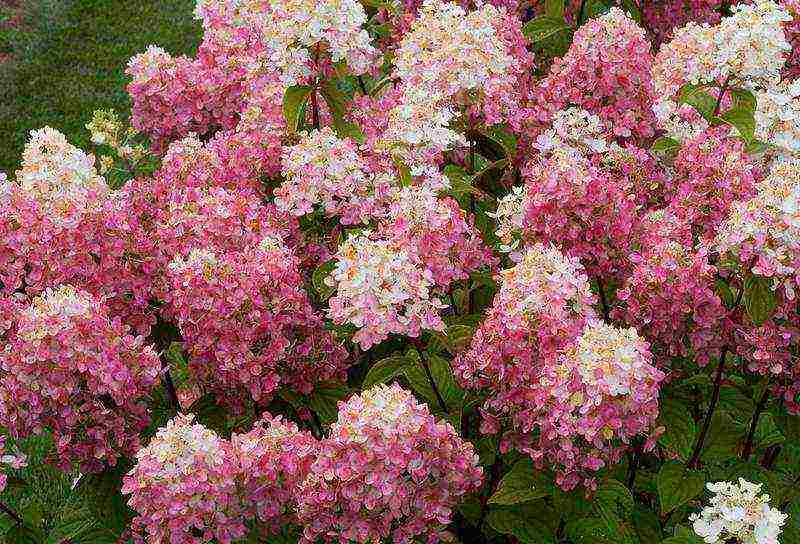
Hydrangea paniculate planting and care in the open field photo
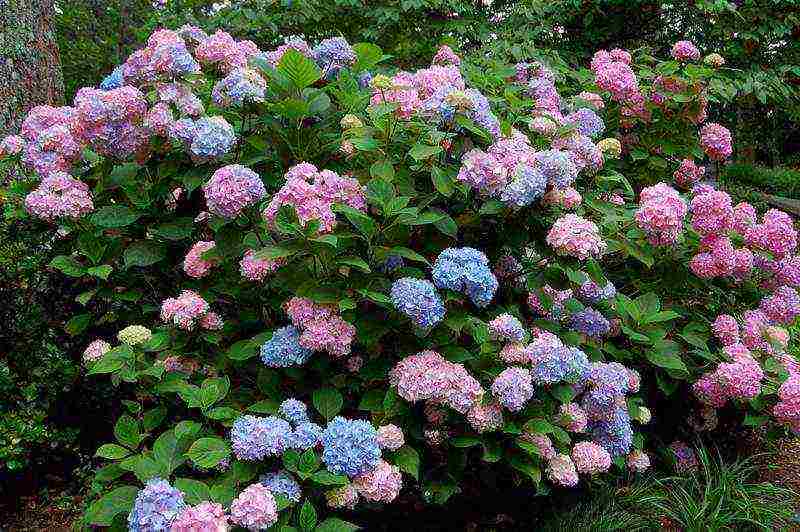
Hydrangea large-leaved planting and care photo

Hydrangea in garden design photo of flowering
Until recently, garden hydrangea was not very popular among domestic gardeners. However, in recent years, hydrangea flowers are increasingly appearing not only in the summer cottages of amateur flower growers, but also in landscape projects of professional designers.
In recent years, flowers have increasingly appeared in landscape projects of professional designers.
Breeders regularly delight connoisseurs of this plant with new varieties of incredible shapes and colors, which can become a worthy decoration of any park or flower garden. In this article, we will introduce you to the most popular specimens suitable for Russian gardens, as well as consider the basic recommendations regarding cultivation and care.
a common part
Most of the hydrangeas are shrubs, but there are also vines and even standard trees.They can be deciduous and evergreen, huge and dwarf. On the territory of Russia, tree-like and paniculate species are mainly grown that can withstand the harsh Russian winters.
Stalked hydrangea is used for vertical gardening
Many gardeners successfully breed petiolate varieties suitable for growing in the milder climates of East Asia. This type is used for vertical gardening, its stems grow in the form of vines, which firmly braid the supports, gazebos or walls of buildings. To protect the plants from freezing at low negative temperatures, the stems should be removed in winter and carefully insulated with a covering material.
Panicle hydrangea in most cases is a deciduous shrub with broad-pyramidal inflorescences about 25 cm long, but it can also grow in the form of a tree. However, in recent years, breeders have bred varieties with larger panicles, sometimes reaching 40 cm.The leaves are green, oval, 10-12 cm long.
Treelike hydrangea is a shrub that reaches 3 meters in height, with spherical or hemispherical inflorescences.
Popular varieties
Consider the most popular types and varieties:
- Pinky Winky
Sometimes the tree-like deciduous Pinkie Winky hydrangea, bred in 2003 by breeders from a Belgian university, is called Sakhalin
Sometimes the tree-like deciduous Pinky Winky hydrangea, bred in 2003 by breeders from a Belgian university, is called Sakhalin. For a decade and a half, she has gained incredible popularity among gardeners. Unlike other varieties, panicle hydrangea has strong stems that do not bend under the weight of large inflorescences. She absolutely does not need to install supporting elements during the flowering period, which has a positive effect on the appearance of the plant.
The crown is dense, spherical, well-kept in shape, with a diameter of up to 200 cm.The height of the plant reaches 200 cm, the average annual growth is about 30 cm.
The cone-shaped inflorescences, which bloom in early June, gradually change from their creamy white color to purple. The rich green foliage turns red in the fall, and the bush stands out as a bright spot of fire against the background of the entire garden.
- Bella Anna
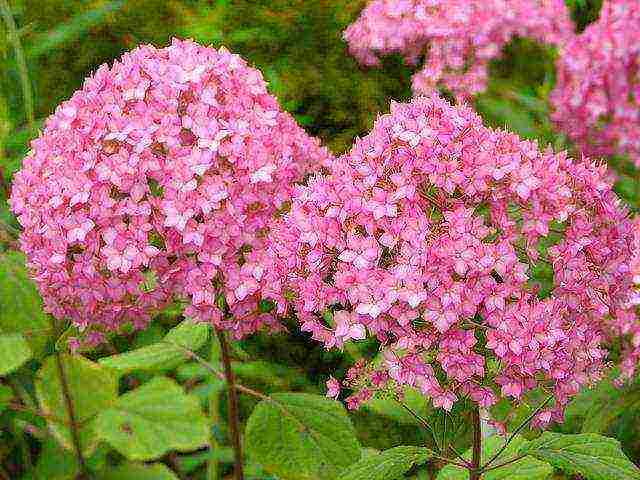
Hydrangea Bella Anna is another new variety of tree hydrangea, the spherical inflorescences of which are painted in bright pink
Another new variety of tree hydrangea, the spherical inflorescences of which are painted in bright pink. Flowers bloom in early summer and bloom before the onset of autumn frosts.
The bush is compact, the height rarely exceeds 130 cm. The crown is round, dense, dark green oval leaves on the lower side have a lighter color. In autumn, the foliage turns bright yellow. The plant is frost-resistant, does not require shelter in the cold season.
- Anabel
An old variety, well known since 1746. Deciduous shrub with a spreading crown up to 300 cm in diameter, about 250 cm high.
Flowering period - from July to October, massive hemispherical inflorescences, up to 25 cm in diameter, milky white. Under the weight, the branches fall to the base of the soil and need to be installed.
- Vanilla freise
The brainchild of French breeders. Panicle hydrangea 200 cm high and of similar diameter. Vanilla freise belongs to frost-resistant varieties, withstands in snowy winters up to - 29 degrees without shelter.

Anabel is an old hydrangea variety well known since 1746
Inflorescences are pyramidal white at the top, and strawberry pink at the base. The brushes are massive, some up to 40 cm in length.
- Jomari
A low shrub, rarely exceeding the 80 cm mark, with rounded lilac-pink peduncles.
- Limelight
An old variety known since 1829. Wide-pyramidal inflorescences of white color with a light lime tint with the onset of autumn change their color to pale pink.Limelight withstands partial shade well; being in the shade for most of the daylight hours does not affect the quality of flowering.
- Nikko Blue
A medium-sized variety with a height of 120-150 cm. Inflorescences are spherical, slowly changing color during the season from white to blue.
The soil
Hydrangea Nikko Blue
In order for a flowering bush to delight you with long flowering, it is necessary to provide it with comfortable conditions for growth. All varieties are very demanding on the composition and acidity of the soil, they absolutely do not tolerate alkaline and slightly alkaline soils. They bloom profusely, only growing on acidic substrates with a pH of more than 6. Otherwise, the quality of inflorescences deteriorates, hydrangea flowers become smaller, their color does not correspond to that inherent in this species.
Therefore, before planting in a summer cottage, it is imperative to check the acidity of the soil. Nowadays, litmus indicators are available at any gardening store, with the help of which it is easy to determine the pH at the planting site. In case of discrepancy between the indicators, acidifying components should be added. Of the most commonly used, citric acid can be used by dissolving 1 gram in 1 liter of water, a weak solution of potassium permanganate. If for some reason this method does not suit you, you can add a part of the land from the territory of coniferous plantations to the substrate.
The soil composition for planting is prepared from deciduous soil, humus, peat and sand in a proportional ratio of 2: 2: 1: 1. If the soils are scarce, preliminary application of mineral and organic fertilizers is required.
The flower should be planted in sunny areas. In some cases, it is allowed to plant hydrangeas in open ground in light partial shade, but the shading period should not exceed more than half of the daylight hours. It is desirable that the period of exposure of the plant to the sun's rays falls on the first half of the day.
Watering
If the soils are scarce, preliminary application of mineral and organic fertilizers is required.
Hydrangea responds well to watering and does not tolerate drying out of the topsoil very badly. In dry periods, it is necessary to irrigate the plant several times a week, and young seedlings may need more frequent moistening of the root zone. The best option for retaining moisture would be preliminary mulching of the near-stem space.
However, with the onset of the rainy season, the mulch layer should be removed to prevent decay of the root system.
Pruning
Pruning hydrangeas is a prerequisite for high-quality flowering of the bush. In addition, regular cutting of the bush gives it a neat decorative shape and increases the density of the branches.
In autumn, after flowering stops, the main pruning is carried out, removing all inflorescences so that fragile branches do not break under the weight of the snow layer. If necessary, remove excess density, cutting out obsolete branches at the root and thus rejuvenating the bush.
Stamp forms are cut off not only at the end of the season. To preserve the decorative shape of the tree, root shoots are regularly cut out.
Wintering
Pruning hydrangeas is a prerequisite for high-quality flowering of the bush
In central Russia, most hydrangea varieties are prone to freezing in snowless winters. Ice rains during the period of temporary warming can also cause significant damage to the integrity of the plant. To minimize the likelihood of the death of a seedling, a set of measures should be taken to insulate it.
Hydrangea prefers soils with high acidity, so a shelter with spruce branches will come in handy. In addition to keeping it in the cold, crumbling needles will significantly improve the quality of the soil in the root zone.
Warming procedure:
- The trunk circle is mulched with a layer of sawdust or bark.
- Lay a layer of spruce branches near the trunk.
- Bend the branches of the plant, laying them on the spruce paws.
- The branches of the hydrangea are covered with spruce branches, straw, stalks of corn or Jerusalem artichoke.
- Additionally, cover with a layer of agrofibre, fix around with stones and leave in this form until the cold weather stops.
Reproduction
Garden hydrangea flowers can be propagated without much difficulty:
- taps;
- cuttings;
- division.
- Bends
Reproduction by branches is not difficult for almost any summer resident. The strongest healthy branch is chosen for this. However, if there is a desire or need for rapid reproduction, several branches can be pinned simultaneously on one plant. Rooting begins in the spring.
Rooting order:
- dig a small depression in the ground near the plant;
- bend the prepared branch and sprinkle it with soil mixture on top;
- additionally fixed with a stone or pinned with a wire bracket;
- regularly moisten the soil at the rooting site;
- in the fall, a new seedling is cut off from the mother plant, followed by transplantation at the chosen place.
To minimize the likelihood of the death of a seedling, a set of measures should be taken to insulate it
- Dividing the bush
You should not be afraid to plant this amazing plant with a beautiful name on your site. Garden hydrangea, planting and caring for which does not require special agronomic knowledge, will decorate any site.
Reproduction by dividing the bush is usually carried out at the beginning of the summer season, before the leaves appear. At the same time, it is absolutely not necessary to dig up the entire bush, which is almost impossible when the plant reaches a significant size.
For division, it is necessary to separate part of the branches and cut them off with a shovel at the junction. When digging up the separated part, you need to be very careful, because the root system protrudes far beyond the crown. And the more accurately the fragment of the plant is separated, the faster it will take root in a new place. If there is a possibility, the roots are not freed from soil residues, but are transplanted to a prepared place along with a lump of earth.
- Cuttings
Reproduction by cuttings has a fairly high survival rate and is about 80%. Cuttings are started in spring or early summer, later dates do not allow rooting of the shoot before the onset of cold weather.
Propagation of hydrangea
- Young side shoots are chosen for cuttings. Moreover, you can choose both branches with inflorescences and without them. Divide each branch into fragments with 3 internodes in each. The uppermost part is usually not used, since the probability of rooting is very low.
- The 2 lower sheets are carefully separated, and the upper one is shortened.
- For better engraftment, a root formation stimulator (Heteroauxin or Kornevin) is used, treating the lower cut of the cuttings with it according to the instructions. The most commonly produced form of Heteroauxin is 0.1 gram tablets. One such tablet is dissolved in 5 liters of water and the prepared cuttings are immersed in it for 12-15 hours.
- Rooting is carried out in a mixture of sand with peat or in an ordinary container with water.
If you have chosen the method with a sand-peat mixture, be sure to ensure that the substrate does not dry out. Otherwise, the likelihood of the formation of a full-fledged root system is reduced.
Reproduction by cuttings has a fairly high survival rate and is about 80%
- To create a humid microclimate favorable for root formation, each container is covered with a glass jar or cut plastic bottle. To create a mini-greenhouse, you can use a transparent container, in which all containers with cuttings are installed simultaneously, and covered with glass or a sheet of transparent polycarbonate on top.
- In the evening hours, mandatory airing, watering and irrigation from a spray bottle are carried out in order to increase humidity.
- After 3 weeks, the seedlings can be transplanted to an experimental growing bed. Do not place young rooted shoots in a sunny area to avoid burns. The flower is transferred to a permanent place at the age of 3-4 years.
Planting and care in the open field
Hydrangeas will give you a lot of pleasant hassle. An incredibly beautiful flowering shrub that looks great not only as single plantings, but also as hedges. No less interesting are the standard forms, which can be resorted to in order to save space in cases where the area for ornamental plants is limited in area.
Rate the article:
A variety of private territory, giving it a certain style and beauty - that's what every owner of his own land needs so much. Therefore, hydrangea in the open field is a great option for lovers of abundant flowering shrubs.  A large number of species and varieties will help to create various compositions not only by color, but also by shape. Shrubs of this genus have a large number of colors, which gives them a special uniqueness.
A large number of species and varieties will help to create various compositions not only by color, but also by shape. Shrubs of this genus have a large number of colors, which gives them a special uniqueness.
The ability to properly care for the plant, to create suitable conditions for their life is important. These include: planting hydrangeas in open ground, a variety of cares and reproduction. One of the main activities is planting in a specific place, choosing the right location where the plant will feel comfortable for a long time.
Location of hydrangea in a private area
 Most plants of this species prefer sunny places, which does not quite apply to garden hydrangea. This means that the shrub feels great in partial shade or in the shade, and the area near a building or structure is an ideal place for planting them. It is advisable to plant the plant in acidic soils, then it will be beautiful, bright and lush. If the soils are neutral or alkaline, then they require additional acidification. Very often old nails are buried in the ground for this purpose, which do an excellent job with it.
Most plants of this species prefer sunny places, which does not quite apply to garden hydrangea. This means that the shrub feels great in partial shade or in the shade, and the area near a building or structure is an ideal place for planting them. It is advisable to plant the plant in acidic soils, then it will be beautiful, bright and lush. If the soils are neutral or alkaline, then they require additional acidification. Very often old nails are buried in the ground for this purpose, which do an excellent job with it.
Hydrangea is very demanding for planting and care in the open field, so these issues should be carefully studied in advance.
Planting hydrangeas and features of their reproduction
The ideal time for planting plants of this genus is spring or autumn. And preference is given to the colder period when the plant will not experience excessive moisture loss. High temperatures also negatively affect plant survival.
Planting a hydrangea bush does not always give a positive result, as it is quite anxious and difficult task. Therefore, most gardeners prefer to purchase already grown specimens. This is due to long-term adaptation to external conditions (after about four years, you can plant a hydrangea in open ground - this is considered a very long time in gardening).
How to plant a garden hydrangea on your own territory?
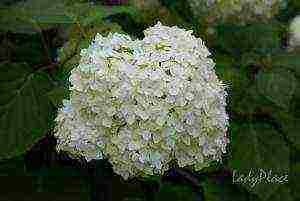 Hydrangea seedlings are planted in pre-prepared pits, about 35-40 cm deep, at least 50 cm wide.If a hedge of shrubs is planned, then the strip should have a width of at least 1 meter. It is also worth remembering about the planting step - the plants are located at a distance of about 2 meters from each other. Hydrangea in the garden is very stylish and modern, gives a certain specific effect, combined with a large number of other shrubs and trees. Therefore, the correct fit is the key to the beauty and health of this species.
Hydrangea seedlings are planted in pre-prepared pits, about 35-40 cm deep, at least 50 cm wide.If a hedge of shrubs is planned, then the strip should have a width of at least 1 meter. It is also worth remembering about the planting step - the plants are located at a distance of about 2 meters from each other. Hydrangea in the garden is very stylish and modern, gives a certain specific effect, combined with a large number of other shrubs and trees. Therefore, the correct fit is the key to the beauty and health of this species.
How to propagate hydrangea?
There are several main ways to reproduce and grow hydrangeas that are especially attractive and loyal:
- Propagation of a hydrangea shrub by layering.
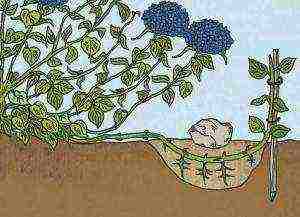 This method is based on the rooting of a young shoot, which is specially bent to the ground in a pre-prepared hole (its depth is about 15 cm).Before bending the branch, it is necessary to make an incision, a match is inserted inside. It is in this place that young roots are formed. Throughout the rooting time, the hole should be watered, you can cover it with a film. When the root system develops, you can grow a young hydrangea, and in the future you get the same beautiful and lush bush.
This method is based on the rooting of a young shoot, which is specially bent to the ground in a pre-prepared hole (its depth is about 15 cm).Before bending the branch, it is necessary to make an incision, a match is inserted inside. It is in this place that young roots are formed. Throughout the rooting time, the hole should be watered, you can cover it with a film. When the root system develops, you can grow a young hydrangea, and in the future you get the same beautiful and lush bush. - Shrub propagation by cuttings - this option is used only in the summer. A stalk is pre-cut from a hydrangea, green annual, 10 cm long. Only the upper leaves and buds are left on the shoot. To make the rooting process faster, the base of the cuttings is treated with a growth stimulant. They can be purchased at almost any specialty store. The soil is prepared in advance - sand, peat and sod land (ratio 1: 1: 1). You can not only prepare it yourself, but also purchase it at the appropriate trading place. A cutting is planted in the ground at an angle, about 5 cm deep. Maintenance requires constant spraying with clean water. The entire rooting process takes about a month.
- In the country, the best option (in the presence of an adult plant) is to divide the bush. Garden hydrangea will take root quickly enough, the main thing is to leave several renewal buds on the excavated plot. The roots should also be treated with a stimulant. After planting, the shrub requires abundant and timely watering. It is sometimes necessary to process the plant for preventive purposes - from the appearance of pests or various bacteria.
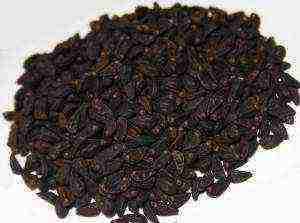 Seed reproduction is the longest and most troublesome way. Seeds are planted in March with follow-up care activities. This is what hydrangea seeds look like.
Seed reproduction is the longest and most troublesome way. Seeds are planted in March with follow-up care activities. This is what hydrangea seeds look like.- At home, you can grow a plant yourself - in the water. The shoot is cut off and placed in clean water, which must be constantly changed to prevent the death of the hydrangea. After 3-4 weeks, the first roots will appear, after which the cuttings are planted in the ground, preferably in a small glass with soil, the composition of which is indicated above. Young plants require regular watering, warm conditions and partial shade. In winter, the plant should be moistened only once a week, otherwise the process of root rotting or the development of harmful bacteria and viruses may take place.

Propagation of hydrangea by cuttings and seeds is the most difficult method of propagation, however, the young plant is the most adaptable and strong as a result. The process itself is quite complicated, which is why not everyone is able to bring the job started to the end.
Hydrangea care activities in the garden
 For a plant to be beautiful, lush, healthy, it is necessary to create certain conditions for it. To ensure them, you need the following:
For a plant to be beautiful, lush, healthy, it is necessary to create certain conditions for it. To ensure them, you need the following:
- Fertilization with organic matter, which includes humus or slurry.
- Top dressing about 1 time in 2 weeks with mineral fertilizers during the period of active growth. Fertilization has a beneficial effect not only on plant growth, but also on abundant flowering. It is not advisable to use this event during the flowering period. If it is wrong to feed hydrangeas, then this can greatly develop foliage, which will not leave room for the formation of inflorescences. Therefore, it is worth taking this issue seriously.
- Any plant requires regular weeding and loosening. The latter is performed 3 times during the whole season. The depth should be from 5 to 10 cm. Weeds should be removed as soon as they appear, in summer, only in the evening or morning. In dry times, there is no need to do this, because you can lead the plant itself to death.
- Watering is frequent and abundant. The complete drying of the earthen coma should not be allowed. Mulch is often used, which protects against excessive evaporation of moisture and overheating of the soil.
- Pruning refers to an important event that directly affects the quality and scale of inflorescence formation.In the fall, you need to get rid of faded flowers. Old plants are subject to complete renewal, which means that they are cut almost at the root. And young ones - in the spring, are pruned to the formation of buds. In the first year of flowering, it is better to break off only the tied inflorescences, which contributes to the development of more of them over time.
- Protection of hydrangea in winter - shelter with various materials - burlap or spruce branches, sawdust.
- Hydrangeas have a unique feature - the ability to change the color of the inflorescences.
 Specialty stores sell original solutions for these purposes. For example, to obtain pink flowers, potassium permanganate or peat is used. To make the shrub grow blue, aluminum sulfate or iron crystals are used. The blue hydrangea tree is shown in the photo.
Specialty stores sell original solutions for these purposes. For example, to obtain pink flowers, potassium permanganate or peat is used. To make the shrub grow blue, aluminum sulfate or iron crystals are used. The blue hydrangea tree is shown in the photo.
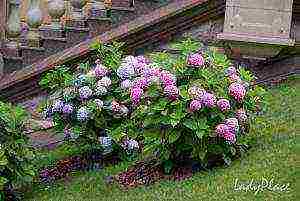 Hydrangea is tree-like, paniculate, gardening in planting and care is quite difficult, but the result cannot but please. That is why this plant has become so popular for modern landscaping.
Hydrangea is tree-like, paniculate, gardening in planting and care is quite difficult, but the result cannot but please. That is why this plant has become so popular for modern landscaping.
The presented photos perfectly prove this fact.
Hydrangeas are used not only for landscaping in areas near the house, but also in street improvement. They make wonderful hedges, just group plantings, beautiful compositions.
Article author: LadyPlace


